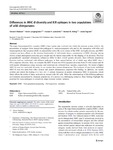Differences in MHC-B diversity and KIR epitopes in two populations of wild chimpanzees
Maibach, Vincent
Langergraber, Kevin
Leendertz, Fabian H.
Wittig, Roman M.
Vigilant, Linda
The major histocompatibility complex (MHC) class I genes play a critical role within the immune system, both by the presentation of antigens from intracellular pathogens to immunocompetent cells and by the interaction with killer cell immunoglobulin-like receptors (KIR) on natural killer cells (NK cells). Genes of the MHC are highly diverse, and MHC variation can have effects on the immune functionality of individuals; hence, comparisons of MHC diversity among closely related phylogenetic taxa may give insight into the factors responsible for the shaping of its diversity. The four geographically separated chimpanzee subspecies differ in their overall genetic diversity, have different population histories, and are confronted with different pathogens in their natural habitat, all of which may affect MHC class I DNA sequence diversity. Here, we compare the MHC-B exon two DNA sequence diversity from 24 wild western and 46 wild eastern chimpanzees using necropsy and noninvasively collected fecal samples, respectively. We found a higher MHC-B exon two nucleotide diversity, in our western than eastern chimpanzees. The inclusion of previously published MHC-B exon two data from other western and eastern chimpanzees supported this finding. In addition, our results confirm and extend the finding of a very low C1 epitope frequency at eastern chimpanzee MHC-B molecules, which likely affects the ability of these molecules to interact with NK cells. While the understanding of the differing pathogen environments encountered by disparate populations of a species is a challenging endeavor, these findings highlight the potential for these pathogens to selectively shape immune system variation.
Dateien zu dieser Publikation

